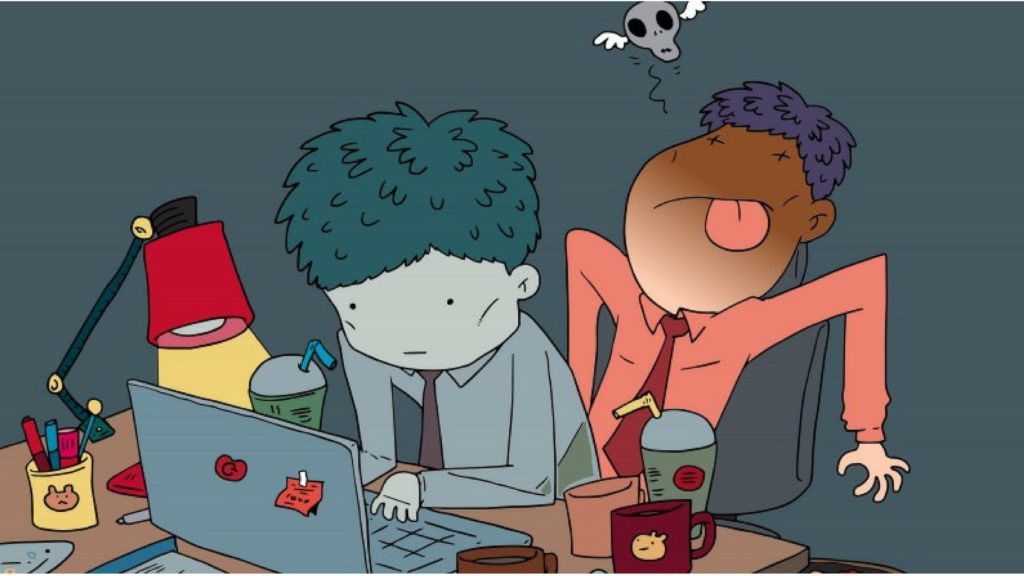Summer School Six – Teachers Contain Fear for A Living…then Teach

Learning is a Sharing Experience…Teaching Should be Too.
What you do in Our Classrooms is Up to You
A friend of mine was recently enticed into enrolling on a CPD training entitled “Empowering Women in the Classroom”. The training took place over zoom. As she took her place in front of her monitor, she noticed that over 90% of the other participants were women, like her, working on the frontline in state secondary schools. The trainer was a retired teacher, a man, who proceeded to tell the trainees about his time as a teacher in a boys school and the contrast of that experience to his latter career in a girls school. The crux of the training quickly emerged as the difference between the way boys and girls learn. Nothing wrong with that, but not quite on topic some would say.
After 10 minutes of an hour training, my friend began doing other work, catching up with emails, making lists of what she needed to do the following day etc. She was waiting for the Q and A and discussion so she could compare experiences with her colleagues. It never came. After an hour, the trainer signed off and wished them all well with teaching girls.
In essence, what happened was this, a man took a training on empowering women – er…really? – and then gave the women in the ‘room’ no opportunity to explore their shared experience. You could say, he presented a fait-accompli, a ‘this is how it is’ rather than a possibly more useful question ‘How is it for you?’
The point here is not that he was bad man or that a training on the influence of gender on learning is not an important topic. It’s more that we seem stuck in education with a model of learning that sometimes excludes both the learner and the possibility of learning something unexpected from our shared experience. It is binary. I, as the teacher, download my knowledge into you, the learner.
This happens in classrooms (and training rooms) all the time.
We are Learning Machines
But this is not, according to psychology, how we, as humans, are wired to learn. It is actually entirely counter intuitive to the way we learn.
“The psychology of learning is a broad church but a common theme of all of its teachings is that humans are learning machines.”
The psychology of learning is a broad church but a common theme of all of its teachings is that humans are learning machines. We are innately wired to do it. More than this, we are wired to learn in the context of relationships; relationships with people first and with subjects second.
We are born into a relationship with an-other, our primary carer. Winnicott famously said “There is no such thing as a baby…” What he meant was that the fundamental meaning of being a baby is that you are a baby ‘of’ someone – a mother or carer. Bion, later took this further saying that there is no such thing as an individual, there is only ever an individual who is part of a group. In other words we exist in the context of others.
We are raised in a group dynamic – our family and we form communities in which to exchange information in order to stay safe and thrive. It is through relationships with others that we learn to understand the world and something of ourselves and our place within it.
Neuroscientist, Matt Carland, says “…the reason we humans evolved such large and sophisticated brains…wasn’t to invent rocket science – but rather simply to keep up with our complex social environment.”. Humans are driven to form relationships. Yet we structure learning environments and experiences as though the opposite were true. Rather than begin from a place where relationships are wanted and others are naturally curious, we begin from a premise that no one really wants to ‘know’ anything or anyone new. As such we continue to scrape the surface of what is possible. We dust a room with learning rather than dig into the earth and find the roots of how to relate to it and to others through its application. Along the way we discount our own experience and that of others. We stick to facts as though they are enough to communicate the meaning. Worse, we use the facts to obscure the meaning. And we do all of this because too often we fear our learners.
Born out of Fear
Discounting learners and their experience, either intentionally or unintentionally, is born out of a fear that our learners may overwhelm us by bringing experiences to the classroom that we, as the leaders of learning, are unable to contain. At its heart it is built on the belief that those we teach are not to be trusted with the learning we’ve prepared for them.
And it is predicated on the idea that our leaners are not arriving in the room to learn. And it is a belief that is fundamentally misplaced.
When we believe that learners arrive in the room resistant to learning we spend a lot of time either trying to convince them that they have to learn, it’s good for them, or singing and dancing and dressing learning up in sparkly clothes or leaving out the hard bits or disguising it as something we imagine to be more palatable. In other words, we treat the learning as a foreign object, a pill that must be swallowed rather than a meal our students are hungry for. Trying to make learning fun is laudable but sometimes we give our learners the message that they are somehow unequal to the real task and by doing so we discount them and their experience out of hand.
Some years ago, as a beginning teacher, I entered a classroom with one thing on my mind, “Get through the hour…Get through the hour…Get through the hour…”. I was afraid of what might happen if I didn’t keep strict control of every moment of my lesson and had it planned to last millisecond. Yet, what happened, and it happens a lot, the message or lesson those pupils were learning from me was not about Hamlet’s view of his father, but that I was desperate to get out of the room and away from them as quickly as possible! So, not surprisingly, the lesson didn’t go well. Within a few minutes, they were responding not to the content of the lesson but to the lack of positive connection I was making with them. I had planned a lesson after all that was designed to pin them up against a wall and ram as much learning down their reluctant throats as I could before retiring to the staff room and breathing a sigh of relief.
Our Greatest Learning Resource is One Another
Our greatest learning resource is one another and our shared experiences. Teachers and trainers are relaters, they are there not to be the source of learning but the inspiration, the breather of life into a topic. Their skill is in understanding and containing the fear that comes with meeting something new and redirecting it into the excitement of knowing someone or something as yet unknown or unexplored.
Confronting what frightens us is difficult. However, not to do so, means that we are driven to act out and behave as though our fears are true. Positioning others as not wanting to hear what we have to say before we have opened our mouths may be a way of protecting ourselves but it is not a useful framework on which to base a learning experience, environment, institution or culture.
Our Early Experiences
Psychodynamic psychologists argue that any effective learning experiences replicates our earliest feeding experiences. In order to be calm enough to feed, the infant needs to feels safe enough. Their anxieties – life threatening in their developing understanding of the world – need to be placated before they are able to attach and imbibe what they need to survive. The experience is more than perfunctory. It is pleasurable and life giving. It fills them up, not just with nourishment but with a sense of completeness and connectedness. They are, in those moments, re-connected to what has been lost in the separation of birth.
The argument goes that this experiences of connecting to ‘source’, to ‘food’, remains innate all of our lives. We want to connect to others, to relate to them and what they have to offer. Not just because it is intellectually ‘interesting’ but because it is fundamentally life affirming. It returns us to those early experiences when we were feeding and feeling connected and whole. But like those early theatres of feeding, our theatres of learning need to feel safe enough before we are able to connect to what we innately want from teachers, from lecturers, from learning itself.
One of the ways an infant is helped to feel safe is through the mechanism of ‘containment’. Overwhelmed with grinding pangs of hunger, terrified by disconnection, lost and abandoned, the infant spits out its fear in cries of desperation and rage. The screams land in the carer like sharp arrows of negative emotion. Yet, the carer, able to see the cries not as personal attacks, is able to reconstitute these arrows as messages and cries for help. This facilitating role, taking one thing – the raw anger and frustration of the infant – and transforming it into satisfaction and pleasure by calming its cries and helping the infant feel safe is the role of containment. And containment is the primary function not only of any carer but also of any teacher or lecturer or leader.
Like the infant, the drive in the pupil in school, the student in college or the employee in any organisation has an instinctive drive to connect and relate, they have no choice, they are wired that way. However, first they will send a forward party if you like, those parts of themselves that feel anxious and fearful and they will test the carer to see whether they can make it safe enough for them to open up to do what they are configured to do, connect, share, co-operate and learn.
We would rather Avoid what Frightens Us
I recently lead a training with a school preparing for an Ofsted inspection. The school knew the inspection was coming and wanted to prepare staff. They had spent a long time on achieving a level of consistency across the school with lesson planning and delivery, protocols and processes. I was invited in to help staff psychologically prepare for the experience. There was a lot of fear and anxiety around concerning the inspection which emerged in the meetings I had with the senior team around the content of the training. Although they knew that staff were worried and wanted to help, they were also fearful that I would, by inviting staff to say how they were feeling about the imminent visit, unleash feelings that would just destroy their careful preparation. The fear seemed to be that once the lid was off, it would not be possible to put it back on. It was touch and go whether it would go ahead. The training went ahead and consisted, for the most part, in exploring what staff were expecting from the inspection, what they felt the school expected of them and where they thought they might fall short. No thoughts were off limits. The message of the training was that the fears we/they had were natural but maybe out of proportion to the process they were about to face. I had them all do drawings of what came to mind when they heard the word “Ofsted”. The drawings were extraordinary. From monsters to gangsters, they expressed something of the inner fears these teachers were experiencing and when shared and discussed became harmless and often hilarious.
In this instance the school was acting as the containing parent. They were allowing the staff to get beyond their fears and anxieties on a personal and institutional level and so connect to what they were innately driven to do, gain satisfaction through connection, relationships and co-operation.
I have long argued that teachers be equipped not just with this knowledge of parent/infant psychology but also with a method of reconnecting to this essential truth before any lesson, seminar or act of group leadership. If fear is not contained then we will continue to create classroom and staff room environments that are built on separation, on suspicion of the other and as a consequence we will naturally use our lessons and training not to teach or lead collaboratively but to keep our learners and our staff members and their experience at arms -length.








Responses